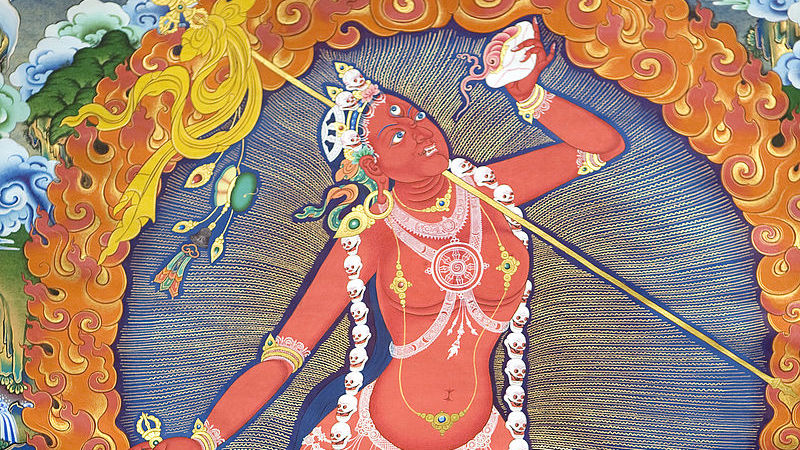Vajrayogini (Tib. Dorje Naljorma) is a supreme goddess in the pantheon of Vajrayana Buddhism. Her name can be translated as “diamond” or “indestructible” yogini. “Vajra” (Tib. dorje), in the Buddhist context, refers to the indestructible power of enlightenment. She is perceived as an embodiment of complete buddhahood in female form. Her femininity expresses the idea that the potential of the mind and the attainment of spiritual perfection are beyond genders. She has attained complete awakening, which is expressed through her divine body, serving as a model for contemplation and meditation. Originating from the Highest Yoga (anuttara-yoga) Tantra, she embodies the union of transcendental wisdom and compassion, as well as emptiness and bliss. In Vajrayana, these qualities characterize the enlightened nature and manifest spontaneously and in unity.

Vajrayogini is one of the Buddhist goddesses who is perceived as the “supreme cosmic female deity” and the principal dakini in the Tantric pantheon. In this role of her, she is met with various epithets: “indestructible dakini,” “supreme dakini,” “primordial wisdom dakini,” “fully awakened dakini,” “dakini, which is the essence of all Buddhas,” and so on. Vajrayogini symbolizes the wisdom of all enlightened beings and embodies the impulse of inspiration that drives the Buddhas to attain the perfect enlightenment.
The enlightened nature of Vajrayogini is comprehensive and immeasurable. The goddess has gained complete control over her emotional states and can handle them at will and manifest them in their diversity as part of her enlightened activity (Tib. trinle). She expresses boundless wisdom, sensual femininity, and fearsome anger. In Buddhist texts she is often called “wrathful” (Skt. ugra), “terrifying” (Skt. atibhīma), “abusive” (Skt. pracaṇḍa), and more. Her wrathful qualities can be interpreted in different ways. They are a sign of the achievements of the yogic practice and mastering the path to enlightenment.
They also reflect the intensity of her inner fire (Skt. chandali, Tib. tummo), which purifies the subtle nervous system and the karmic obscurations (Skt. āvarana, Tib. lekyi dribpa). As a result of this purification, the indivisibility of transcendental wisdom and bliss can be achieved. In this way, her wrathful image symbolizes the unity of emptiness and bliss (Tib. detong) that is beyond all states of mind. Vajrayogini has the power to defeat all negative forces and demonic beings, assuming that their true self is empty. This applies in particular to the destructive emotions such as anger, hatred, greed, selfishness, attachment, and ignorance.
As a fully enlightened being, Vajrayogini manifests in the three bodies of the Buddha (Skt. trikāya, Tib. kon chog sum) – dharmakaya, sambhogakaya, and nirmanakaya. Her nature unfolds on different levels, depending on the depth of wisdom she represents. Her external aspect refers to her spontaneous manifestation as the sambhogakaya and nirmanakaya incarnations that reside in various sacred places in the human world. Her internal aspect is associated with the practice of yoga. Her secret aspect is the mind of clear light, which is originally pure.

Vajrayogini resides in the pure land called Khechara (Tib. kha cho), located in the Akanishta heaven, inhabited by numerous enlightened beings. The notion of such celestial settlements related to the Buddhist idea that they could be perceived once the consciousness had been completely purified. They represent higher levels of the mind, which are attained after a certain spiritual preparation. Practitioners who have realized the practice of Vajrayogini are believed to be able to transfer to Khechara after their death. During their cremation, rainbows appear as a sign that their bodies are dissolving in the light of the Buddhist paradise. The most advanced practitioners are able to dissolve their physical body in five colored light, leaving only hair and nails. This phenomenon of the so called “rainbow body” (Tib. jalu), is described in the teachings of the Great Perfection (Tib. Dzogchen).


